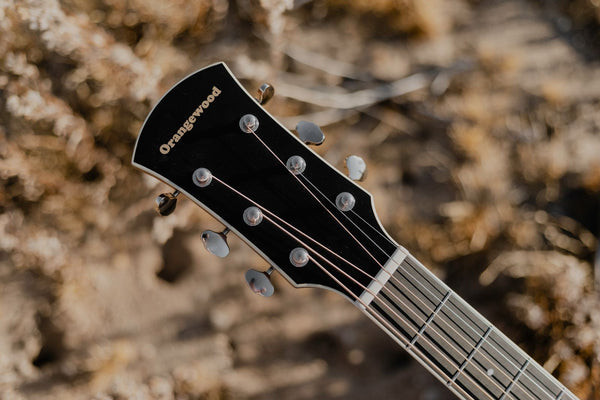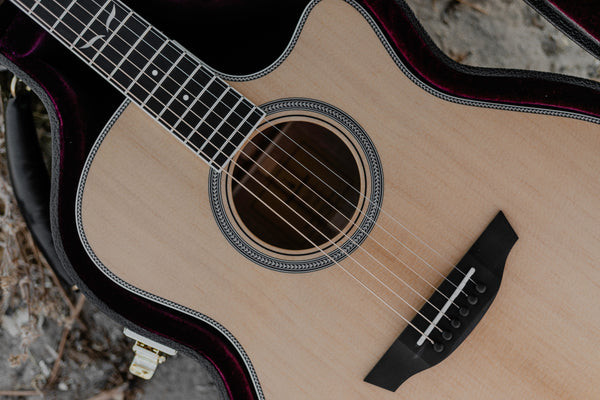Embarking on the journey of learning acoustic guitar is an exciting endeavor. A crucial first step in this musical adventure is to become intimately familiar with your instrument. Knowing the correct terminology for each part of your acoustic guitar is essential for effective communication with instructors, fellow musicians, and for understanding maintenance guides. Don’t worry if it seems daunting; this guide will break down the anatomy of an acoustic guitar in a clear and accessible way.
Exploring the Anatomy of Your Acoustic Guitar
Understanding the different components of your acoustic guitar will not only improve your guitar vocabulary but also deepen your appreciation for the instrument itself. Let’s delve into each part, from the headstock to the bridge.
The Headstock: The Command Center of Your Guitar
The headstock is located at the very top of the guitar neck and serves as the anchor for the tuning pegs. A robust headstock is vital because it must withstand the constant tension exerted by the strings. The design and shape of the headstock can vary between guitar brands, often becoming a recognizable feature.
Tuning Pegs (Tuners)
Tuning pegs, or tuners, are mechanically geared knobs mounted on the headstock. They are used to adjust the tension of each string, thereby changing its pitch and tuning the guitar. When you replace your guitar strings, you’ll thread each string through a hole in the corresponding tuning peg and wind it to achieve the correct tension.
 Close-up of a guitar headstock showcasing the tuning pegs
Close-up of a guitar headstock showcasing the tuning pegs
The Neck: The Pathway for Your Music
Extending from the guitar’s body, the neck is a long piece of wood that includes several crucial components: the fretboard, frets, headstock, and truss rod. It’s the part of the guitar you hold and where your hand navigates to create different notes and chords.
Nut
Positioned at the junction of the headstock and the fretboard, the nut is a small, typically hard material piece with grooves for each string. The nut’s primary function is to maintain consistent string spacing and string height (action) as they extend from the headstock to the fretboard. It also plays a role in transmitting string vibrations to the neck wood.
Fretboard (Fingerboard)
The fretboard, also known as the fingerboard, is a strip of material, often a different type of wood than the neck itself, laminated to the neck’s surface. This is where your fingers press down on the strings to produce different notes and chords. The wood choice for the fretboard can significantly influence the guitar’s playability, comfort, and overall tone.
Frets
Frets are the thin metal strips embedded across the fretboard, running perpendicular to the strings. They are precisely positioned to divide the fretboard into semitone intervals. Pressing a string down behind a fret shortens the vibrating length of the string, thus producing a specific musical note. Standard acoustic guitars often have around 20 to 22 frets.
Fret Markers and Inlays
To help guitarists navigate the fretboard, markers or inlays are embedded into the fretboard surface. These visual cues are typically dots or decorative shapes and are usually found at the 3rd, 5th, 7th, 9th, 12th, and 15th frets. Orangewood guitars are distinctively marked with a leaf inlay, a signature design element.
Truss Rod
Concealed within the neck is the truss rod, an adjustable metal rod. This component is crucial for controlling the neck’s curvature or bow. Adjusting the truss rod can affect the guitar’s action (string height) and playability. If you find your guitar becoming difficult to play or frequently going out of tune, adjusting the truss rod might be necessary.
The Body: The Heart of Acoustic Resonance
The body is the largest part of the acoustic guitar and significantly impacts the instrument’s overall tone and volume. Acoustic guitar bodies come in various shapes, each with unique tonal characteristics. Popular body shapes include dreadnought, grand concert, grand auditorium, parlor, and smaller travel-sized models. The body comprises the soundboard (top), back, and sides.
Soundboard (Top)
The soundboard, or top, is the primary vibrating surface of the acoustic guitar. It’s usually crafted from tonewoods like spruce, cedar, or mahogany, chosen for their resonant properties. The soundboard vibrates in response to string vibrations, projecting the guitar’s sound. The choice of tonewood for the soundboard is critical in determining the guitar’s tonal character.
Tonewood
Tonewood refers specifically to the wood used for the soundboard. Different wood species possess unique densities and grain patterns, which translate to distinct tonal qualities. Common tonewoods include spruce (bright and articulate), mahogany (warm and mellow), and cedar (rich and responsive). Orangewood Guitars often feature spruce, mahogany, and pau ferro tonewoods in their construction.
Sound Hole
Unique to acoustic instruments, the sound hole is the opening in the guitar’s body directly beneath the strings. It allows the sound produced by the vibrating soundboard to resonate and project outwards. While sound emanates from the entire body surface, the sound hole is crucial for allowing sound to escape freely, contributing to the characteristic acoustic guitar sound.
Rosette
The rosette is the decorative inlay pattern encircling the sound hole. Rosettes are often intricate and can be made from various materials like wood, plastic, or abalone. Orangewood Guitars use different rosette designs to distinguish their various collections, such as the modern elegance of the Melrose collection or the vintage-inspired Highland series.
Pickguard
Located on the body, adjacent to the sound hole, the pickguard is a protective piece of material, usually plastic or tortoiseshell. It shields the soundboard from scratches and wear caused by guitar picks or fingernails during strumming. Pickguards come in various shapes and sizes, contributing to the guitar’s aesthetic. Orangewood Guitars offer optional pickguards with many models, allowing players to customize their instrument’s appearance.
 Image highlighting the bridge area of an acoustic guitar, including the bridge pins and saddle
Image highlighting the bridge area of an acoustic guitar, including the bridge pins and saddle
The Bridge: Connecting Strings to Sound
The bridge is located on the guitar’s body, opposite the neck, and serves to anchor the strings to the body. It’s a critical component for transferring string vibrations to the soundboard.
Bridge Pins
Bridge pins are small pegs that secure the strings into the bridge. They are inserted into holes in the bridge and hold the ball end of the guitar strings in place. Bridge pins are typically made from materials like plastic, wood, or bone, and can influence the guitar’s tone to a subtle degree. They are removed and re-inserted whenever you change your strings.
Saddle
The saddle is a thin strip of material, often bone, Tusq, or plastic, situated on top of the bridge. The saddle elevates the strings to the correct height above the fretboard (action) and transmits string vibrations from the bridge directly into the soundboard. It is a crucial component in the sound transmission chain of the acoustic guitar.
 Full view of an acoustic guitar showcasing all components discussed
Full view of an acoustic guitar showcasing all components discussed
Conclusion: Your Acoustic Guitar Vocabulary
Becoming familiar with these Acoustic Guitar Components is a fundamental step in your guitar learning journey. Understanding the name and function of each part will not only enhance your communication with other musicians but also empower you to better maintain and appreciate your instrument. As you continue to learn and play, this knowledge will become invaluable. Explore further resources and continue your musical exploration on guitarplayers.net!
